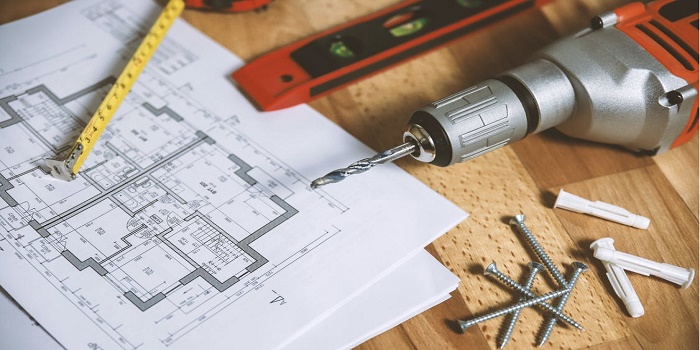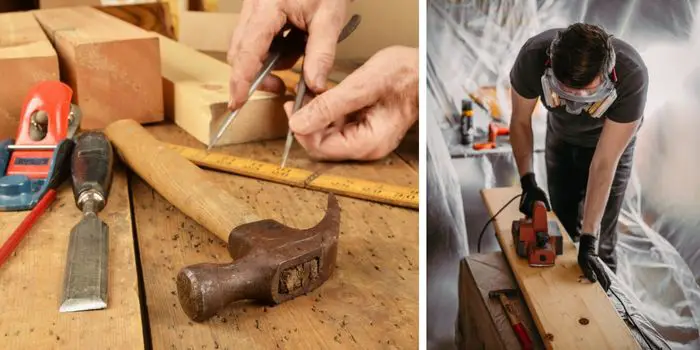
Carpentry as a profession is a very old one, but it is also a very versatile one. A carpenter can work in different types of settings, from residential to industrial and everything in between.
And with increasing demand in this industry, it’s becoming one of the most lucrative and profitable professions worldwide.
No matter what your carpentry goals are, though, there are a few skills that you will need to master before you can truly call yourself a carpenter.
If you are new to carpentry or just thinking about getting started, in this article, I will discuss these carpentry skills in a bit of detail. These skills are not difficult to learn, but they are important nonetheless.
Carpentry Skills for Beginners
Getting your foundations strong is the key to success in the carpentry business. With advancements in tools and technology every single minute, there are many skills that a carpenter must master to be successful.
However, if you are just starting, you should focus on the most important and basic skills a carpenter should have. These are as follows:
1. Measuring the Surfaces Accurately
This is an essential skill for a carpenter to master. A carpenter must be able to accurately measure lengths, widths, and depths to create level and plumb surfaces and create frames that fit perfectly together.
It is not only important for the aesthetic value of the final product but also for the structural integrity.
With a wide variety of measuring and marking tools available, this can be easily learned with little practice.
2. Cutting the Straight Lines on Wood
Another important skill for carpenters is the ability to cut the piece of lumber straight.
A good carpenter must be able to cut straight lines using various tools, such as a handsaw, power saw, or miter saw.
This skill is important for creating level and plumb surfaces, as well as for creating frames that fit perfectly together.
Particularly, a miter saw is an important tool for a carpenter to master as it allows the user to make precise cuts at various angles.
3. Drilling Holes in Wood
Drilling holes is an important carpentry skill for several reasons. First, it allows you to create clean, precise holes in a wide variety of materials.
Second, it allows you to create holes of different sizes and depths, depending on the needs of your project.
Third, drilling holes is a great way to avoid irregularities and imperfections when using other methods, such as sawing or chiseling. Mastering this skill will give you the confidence to tackle more complex projects that require precise hole drilling.
So whether you’re building a bookshelf or a birdhouse, make sure you know your way around a drill bit.
4. Hammering the Nails with Proper Tools
If you want to be a successful carpenter, it’s important to master the skill of hammering nails. After all, what good is a carpenter who can’t hammer a nail?
The ability to efficiently drive nails into wood is essential for many construction tasks, such as building decks, framing walls, and creating roofs.
In addition, being able to properly hammer a nail can help to prevent injuries. A misdirected blow from a hammer can easily cause bruising or even break bones.
As such, mastering the art of hammering nails is an important part of becoming a safe and successful carpenter.
There are also advanced tools such as palm nailers and pneumatic nail guns, which are very helpful in larger projects. Getting proper knowledge about them is also important.
5. Using Different Types of Saws for Cutting
As any carpenter knows, a saw is an essential tool for performing a wide range of tasks.
Whether you’re cutting through lumber or trimming a piece of molding, a saw can help you get the job done quickly and efficiently.
But saws aren’t just for professionals; they can also be incredibly useful for do-it-yourselfers looking to tackle home improvement projects.
Using a saw is one of the most important skills that any budding carpenter can master.
Saws come in different shapes and sizes, each designed for specific tasks. For example, circular saws are great for making long, straight cuts, while jigsaws are perfect for cutting intricate curves and patterns.
And although it can seem daunting at first, with a little practice, anyone can learn how to use a saw like a pro. So if you’re ready to take your carpentry skills to the next level, grab a saw and get started.
6. Understanding the Angles and Joinery
Understanding angles and joinery is important in carpentry for a variety of reasons. To start, they are essential for cutting accurate joinery, whether you’re mitering corners or cutting compound angles.
In addition, a strong understanding of angles can help you avoid common mistakes, such as cutting boards at too steep of an angle, which can make them weaker and more likely to break.
Understanding angles can also help you create more aesthetically pleasing designs. By taking the time to master this essential skill, you’ll be able to create projects that are both functional and beautiful.
7. Creating Level and Plumb Surfaces
As any carpenter knows, level and plumb surfaces are essential for creating sturdy structures.
Without these skills, it would not be possible to build houses, bridges, or even furniture that would stand the test of time.
While level surfaces are relatively easy to create, plumb surfaces require a bit more finesse. In order to create a perfectly plumb surface, carpenters must first establish a level line.
Once the level line is in place, they can then use a plumb bob to ensure that the surface is perpendicular to the ground.
While it may seem like a small detail, mastering the art of creating a level and plumb surface is essential for any carpenter who wants to produce quality work.
8. Building the Timber Frames
Having a good knowledge of building frames is important for carpenters for several reasons. For one, framing is the process of creating the skeletal structure of a building.
This includes putting up walls, floors, and ceilings. In other words, framing is what gives a building its shape.
Additionally, understanding how to frame a building correctly is essential for ensuring that the finished product is strong and durable.
After all, if the frame is not sturdy, the entire structure could collapse. Finally, being able to frame a building efficiently can help carpenters save time and money.
Consequently, it’s clear that having a good understanding of framing is key for anyone in the carpentry trade.
9. Installing Doors, Windows, and Trims
Doors and windows are essential features of any building. Not only do they provide access and ventilation, but they also play a key role in energy efficiency and security.
As a result, carpenters who can install doors, windows, and trims properly can be in high demand.
In order to install doors and windows, carpenters need to have a careful eye for detail. They must take precise measurements and use the correct tools in order to ensure a perfect fit.
In addition, they need to have a good understanding of the different types of doors and windows available in order to choose the best option for each individual project.
By honing these skills, carpenters can become true experts in their field.
10. Finishing the Wood Surfaces
Wood finishing is also an important skill for carpenters to learn for a few reasons. First and foremost, it can help to extend the life of the wood by protecting it from moisture and wear.
Second, finishing can also enhance the beauty of the wood, making it more enjoyable to look at and use.
Many people are willing to pay more for furniture or other items that have been finished to a high standard. In other words, learning how to finish wood surfaces can be a great way to boost your earnings as a carpenter.
So if you’re looking to improve your carpentry skills, be sure to add wood finishing to your repertoire.
11. Reading the Drawings, Plans, and Blueprints
Being able to read drawings and plans is a foundation for every carpenter. After all, these documents provide the carpenter with all of the important information needed to complete a project.
This includes things like the dimensions of the finished product, the type of materials that need to be used, and the sequence of steps that need to be followed.
Without being able to interpret these drawings, blueprints, and plans, a carpenter would be working blind, which could lead to errors and mistakes.
In some cases, these mistakes can be very costly, both in terms of time and money. As such, it is clear that being able to read drawings and plans is a critical skill for anyone in the carpentry trade.
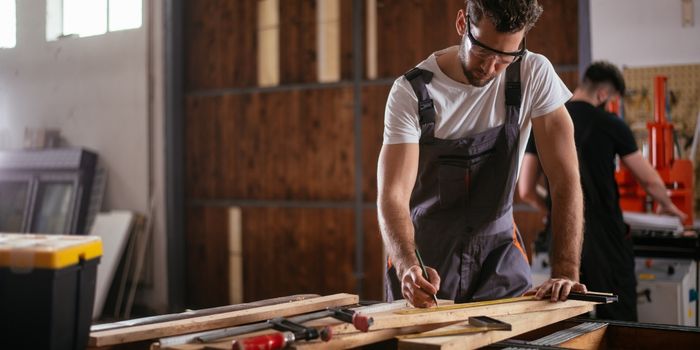
Carpenter vs. Woodworker – What is the Difference?
At its most basic level, a carpenter is someone who works with wood to create or repair structures. A woodworker, on the other hand, is someone who uses wood to create art or functional objects.
The difference is that carpenters are more focused on the construction aspect of working with wood, while woodworkers are more focused on the artistic or craftsmanship aspect.
That being said, there is a lot of overlap between the two trades.
Both carpenters and woodworkers use tools to shape and cut wood, and both can create beautiful and functional pieces. The main difference is in their focus and end goal.
Then there is another term, “Joinery.” Joinery is the art and science of joining two pieces of wood together.
This can be done for a variety of reasons, including creating a stronger connection, adding decoration, or simply making the two pieces fit together better.
Why Learning the Basics is Important for Carpenters?
Carpentry is a great way to start your own business or become self-employed.
It’s also a great way to make some extra money on the side – just think about all of the projects you could take on while working at home.
Carpentry skills are especially getting in high demand due to the current housing market.
And after learning the basics, these skills can be used in a variety of ways – from building a deck to creating custom furniture.
Building carpenter skills is also important because it lays the foundation for quality work.
When you understand the basics—like measuring accurately, cutting precisely, and joining materials properly—you reduce mistakes and save both time and materials.
Strong fundamentals also boost your confidence, allowing you to take on more complex projects with ease.
Moreover, mastering the basics ensures safety. Carpentry involves sharp tools and heavy materials, and knowing proper techniques prevents accidents.
Finally, a solid grasp of foundational skills makes it easier to innovate and customize projects.
Once you know the essentials, you can experiment creatively, turning ordinary projects into unique, high-quality pieces that stand out in the market.
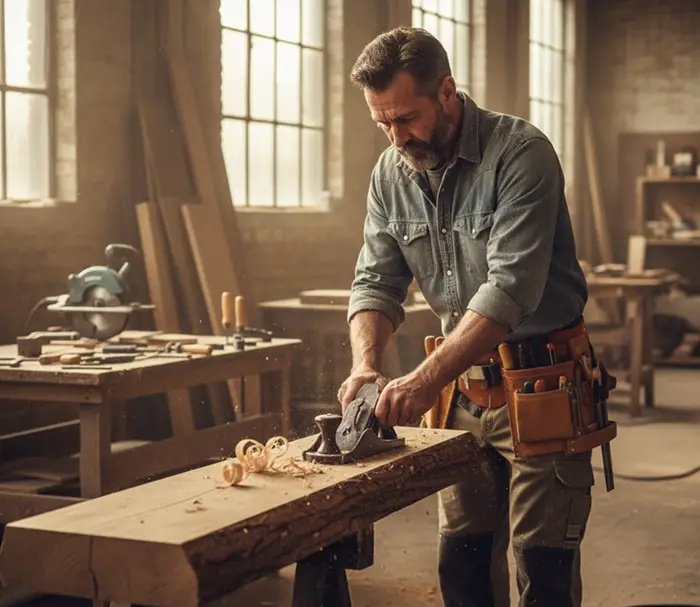
How Much Can a Carpenter Earn with Some Basic Skills?
According to the US Bureau of Labor Statistics, carpenters can take a wage of $15.5 to $38.5 per hour (or $31,800 to $ 80,900 annually).
However, earnings can vary greatly depending on experience, skill level, and location. For instance, carpenters in Alaska earn a median wage that is almost double the national average.
So it’s clear that there is potential to earn a good wage as a carpenter depending on the skills you acquire and the tools you can use.
Where and How to Get the Best Carpentry Skills and Knowledge?
A carpentry skill set can be learned relatively easily, and there are many online resources that can help you get started.
There are also many carpentry courses available, both online and in-person, that can give you more in-depth knowledge about the trade.
The best thing is you don’t need a college degree to be a successful carpenter – just some hands-on experience and training can help you get started.
However, since there are many different carpentry specialties, you can find one that matches your interests and skills.
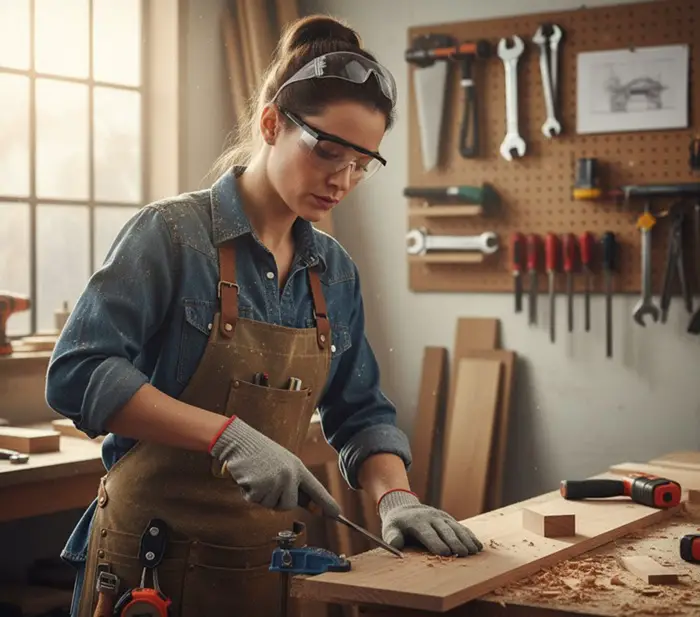
What are the Different Types of Carpentry Jobs that are Available?
There are many different types of carpentry, from rough carpentry to finish carpentry.
Rough carpentry generally involves the construction of the frame of a building, while finish carpentry focuses on the finer details, such as trim and molding.
There are also many specialized areas of carpentry, such as cabinetmaking, shipbuilding, and furniture making.
If you need to improve your carpentry skills, consider taking a course or finding a mentor who can help you learn more about the trade.
There are also many different types of carpentry tools, but you need not master all of them to qualify for carpentry jobs.
Get the knowledge of some of the essential tools that will help beginners, and you are good to go.
What are Some Common Problems that Carpenters Face While Working?
Carpenters may face several problems while working, such as measuring inaccurately, cutting too short or too long, and using the wrong type of wood.
Many times the problems can be in terms of design, planning, and the usage of proper safety gear as well.
It is essential to be aware of these problems so that you can avoid them.
How to deal with the problems?
Carpenters should have a good understanding of geometry and spatial relations to be able to visualize the final product and plan the steps needed to get there.
It is also important for beginners to be able to read blueprints and follow instructions carefully.
When measuring, be sure to use a tape measure, and make sure the surface is level before you start cutting.
Carpenters should also always wear proper safety gear, such as gloves, goggles, and masks, to protect themselves from wood dust and other potential hazards while working.
They should be aware of their surroundings and take precautions to avoid accidents, such as falling objects.
Final Thoughts
Carpentry is a very versatile skill that can be used in a number of different settings. And the above are just some of the basic skills that a carpenter must master in order to be successful.
Carpenters can make a good living, especially if they have specialized skills and knowledge. And with the current housing market, there is a high demand for carpenters.
So if you’re interested in this trade, be sure to get the necessary training and experience. And with a little hard work, you can be on your way to a successful career in carpentry.

Hi, I am Mark Garner a professional carpenter, woodworker, and DIY painter. I live in the small city of Peoria, Arizona as a semi-retired woodworker. I have started this blog with a simple motive to help you with my wood experience in this sector. If you like to know more about what I love doing and how it all got started, you can check more about me here.




